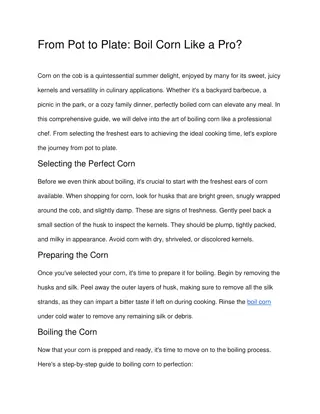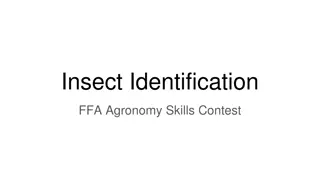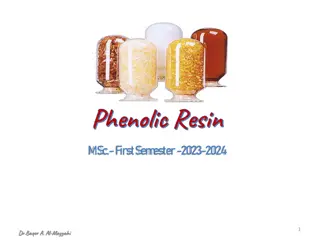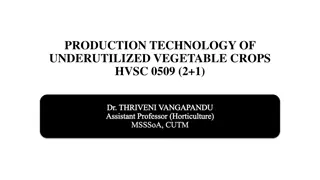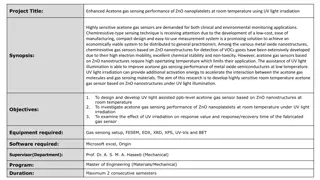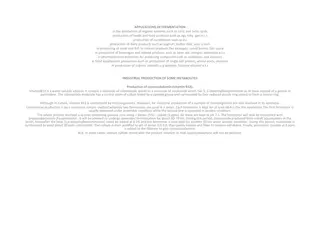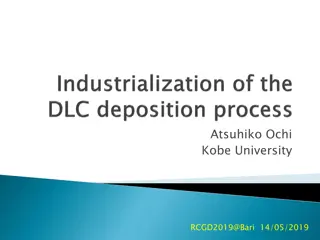Industrial Production of Acetone and Butanol from Corn
Industrial production of acetone and butanol from corn involves a process reported by Beesch in 1953, which includes steps like using specific Clostridium species for fermentation, inoculum preparation, and recovery through distillation. The method has been essential for producing acetone and butanol for various industrial applications.
Download Presentation

Please find below an Image/Link to download the presentation.
The content on the website is provided AS IS for your information and personal use only. It may not be sold, licensed, or shared on other websites without obtaining consent from the author. Download presentation by click this link. If you encounter any issues during the download, it is possible that the publisher has removed the file from their server.
E N D
Presentation Transcript
Unit II Industrial Productions Mr. S. N. Mendhe Department of Microbiology, Shri Shivaji Science and Arts College, Chikhli
ACETONE ACETONE - - BUTANOL FERMENTATION BUTANOL FERMENTATION Strange and Graham Ltd. in England, just before First World War, first production of acetone butanol. Butanol is the main product of acetone butanol fermentation, while acetone is a byproduct of fermentation. Acetone was having a great demand during First World War for producing explosives. Thus acetone butanol industry was expanded rapidly. started industrial
INDUSTRIAL PRODUCTION OF ACETONE AND BUTANOL FROM CORN This process was reported by Beesch in 1953. The method can be divided into following steps. 1) Microorganism 2) Inoculum preparation 3) Preparation of fermentation mash 4) Fermentation Process 5) Recovery by fractionation and distillation
1. MICROORGANISM - Many bacteria can produce small amount of N- butanol but only certain Clostridium species produce this compound acceptable level. These Clostridium species are anaerobic, motile, spore forming rods. These Clostridium species first synthesize butyric acid and acetic acid and then they convert these acids to butanol and acetone respectively. at commercially There are two groups of Clostridium species. Both of which are non pathogenic.
Group I consist of Cl. butyricum which produces acetic acid and butyric acid and gas (CO2& H2) without reducing the acid to corresponding solvents . Group II consist of Cl. acetobutylicum which is able to carry out the further solvents . reduction of acids to
2 2. . INOCULUM INOCULUM PREPARATION Spores of Clostridium acetobutylicum is used for preparing the inoculum. Steps of inoculum preparation are as follows. A) Some of them are added to the sterilized corn or potato mash containing 4 % starch in test tube. The tube with its content is placed in boiling water bath for 90 sec to rejuvenate the culture. The temp of tube is reduced to 370C after which it is incubated for 20 - 24 hrs. B) The content of the tube is used to inoculate conical flask containing 600 ml of sterilized 6% corn mash. C) The content of flask is used to inoculate culture vessel containing 3 lit of sterilized 6 % corn mash. D) The content of the last culture vessel are used to seed about 15000 lit. of sterilized 8% corn mash contained in 20000 lits culture tank. The atmosphere of sterilized inert gas (CO2 maintained over the inoculated mash in order to provide anaerobic conditions and contamination. PREPARATION - & H2) is to reduce the chances of
3 3. . PREPARATION PREPARATION OF When the corn (starchy raw material) is used as a raw material, it is screened & passed over the magnet to remove the dust and metallic ions. The corn is allowed to germinate, corn oil is separated from germinated corn and pressed corn mass is then ground to a fine powder in hammer mill. The ground material is mixed with water to yield 8 to 10 % concentration of corn. The corn mash is then heated at 65 c for 20 min to gelatinize the starch. The gelatinized starch is sterilized at a temp of 1210C to 1270C for 1 hr. The mash is then cooled by a passage a series of double pipe cooler to a temp of 370C. OF FERMENTATION FERMENTATION MASH MASH
4 4. . FERMENTATION FERMENTATION PROCESS The acetone conducted in production tanks having capacity between 50,000 and 500,000 gal. Large numbers of conditions are optimum for fermentation. The optimum temperature for fermentation is 980F. There may be losses of acetone at higher temp and changes the solvent ratio. The pH at the beginning of the fermentation is usually 6.0 to 6.5 and at the end of fermentation is 4.2 to 4.4. Time required for fermentation is 50 to 60 hrs. PROCESS - - butanol fermentations are
Fermentation passes through the three phases. First phase there is rapid growth and production acetic acid and butyric acid & CO2& H2are evolved in large amount. The CO2maintains the anaerobic conditions. pH of fermentation decreases & remains constant for rest of the fermentation. Towards the end of phase after approx. 13 to 17 hrs of the fermentation titrable acidity increases to maximum.
Second phase :- in the second phase of fermentation, there is a sharp decrease in titrable acidity called acid break which coincides with the rapid conversion of the acids to neutral solvents. Acid break is not observed if the fermentation is contaminated with acid producing bacteria. Shortly after the acid break the rate of gas evolution becomes maximum but gradually slows as fermentation progresses.
Third phage During the third phage of fermentation, the rate of gas evolution decreases markedly, decreased rate of solvent production. Many of the cells autolyse at this point, as a result riboflavin is released from the cell into the medium. accompanied by 5. RECOVERY BY DISTILLATION AND FRACTIONATION The harvested fermentation broth transferred to beer still, which comprises of about 30 perforated plates. Fermentation broth enters from the top and the steam is introduced from the bottom. The upward flowing steam vaporizes the solvents. The steam and the vapors are collected and condensed by cooling. Individual solvent is separated by fractional distillation.
MACHANISM OF ACETONE MACHANISM OF ACETONE BUTANOL FERMENTATION Although the acetone butanol fermentation has received extensive study , the actual sequence of chemical events leading from carbohydrates to various fermentation products is not completely clear but it is known that acetic acid and butyric acid are produced first and then converted to acetone and butanol respectively . 1) The glucose is degraded via the EMP pathway to pyruvic acid, which is converted to Acetyl-CoA, CO2& H2. 2) Part of Acetyl CoA is condensed to yield Acetoacetyl CoA. 3) Acetoacetyl CoA is then converted subsequently to - hydroxybutyric acid, crotonic acid & butyric acid & part of Acetyl CoA is directly converted to acetic acid. 4) The butyric acid is then reduced to N- Butanol. 5) Acetoacetyl CoA is also decarboxylated to yield Acetone. BUTANOL FERMENTATION






